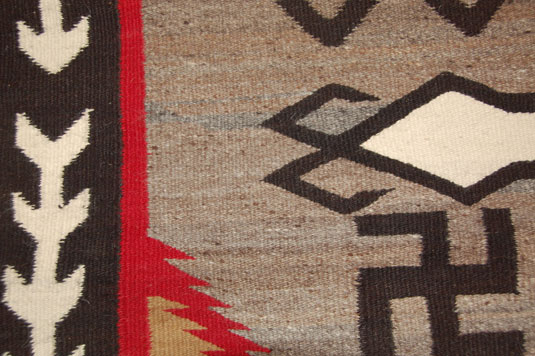Crystal Trading Post Rug with Water Bugs and Whirling Logs [R]
+ Add to my watchlist Forward to Friend
Forward to Friend
- Category: Navajo Textiles
- Origin: Diné of the Navajo Nation
- Medium: wool
- Size: 5’8” x 4’7”
- Item # C3756E
- Price No Longer Available
J. B. Moore of Crystal Trading Post in New Mexico, and J. Lorenzo Hubbell of Hubbell’s Trading Post in Arizona were the two most important traders to the Navajo in the late nineteenth and early twentieth centuries. They not only supported Navajo families in the vicinity of their posts, they promoted the weavers and established a market away from the reservation for the rugs from their looms.
J. B. Moore was a resident of Sheridan, Wyoming, when he bought an interest in the trading post at Washington Pass in 1896. He changed the name to Crystal Trading Post when he took full ownership. Moore was only at Crystal for 15 years but he set into motion a long-term program to benefit the weavers of his area. Following in the footsteps of Sears, Roebuck & Co., he published catalogs from which anyone in the continental United States could purchase Navajo rugs without ever setting foot in the state.
Moore published pictures of 31 Navajo rugs that one could use as a guide for ordering a rug for the home. He stated that these were only suggestions as each weaver may make changes that she felt were justified for her tastes. After Moore departed the post in 1911, his assistant took over and continued running the post in the manner of Moore but certainly allowed weavers to vary from the published ones as long as they kept the same feeling of Moore’s ideas.
This rug follows the trend of the rugs from Crystal Trading Post in the 1920s era. There is a wide black border with white arrows, two large “airplane” white elements in the center, two significant “water bugs” at mid-point and four “whirling logs” in the corners. The older traditional Navajo women most always put a “weaver’s pathway” running from the inner rug to the edge, a guarantee that her talent would be released for a future weaving. The Diné do not believe in closing a circle or other shapes but always leave an opening. This is done on their baskets and pottery as well. Traditional Navajo blankets were borderless so there was no problem, but, when traders insisted on adding borders to make them look more like Persian rugs, they resorted to penetrating the border with a single thread from the center, penetrating every closed line.
The swastika-looking element is known to the Navajo as the whirling log, a pattern taken from a ceremonial sandpainting from the Night Chant, a healing ceremony. In the Diné language, it is called that which revolves and it designates direction and motion. The symbol, having a religious meaning, was not used in textiles until traders such as Moore encouraged the weavers to do so.
Condition: recently cleaned and repaired and ready for use. Some minor staining
Recommended Reading: The Swastika Symbol in Navajo Textiles by Dennis J. Aigner
Provenance: unknown
Whirling Log Symbol: the swastika - or "svastika" from the ancient Sanskrit language - is one of our most universal and positive symbols. Literally it means "auspicious mark", but in various cultures it has signified well-being, highest perfection, happiness, pleasure or good luck.

- Category: Navajo Textiles
- Origin: Diné of the Navajo Nation
- Medium: wool
- Size: 5’8” x 4’7”
- Item # C3756E
- Price No Longer Available



